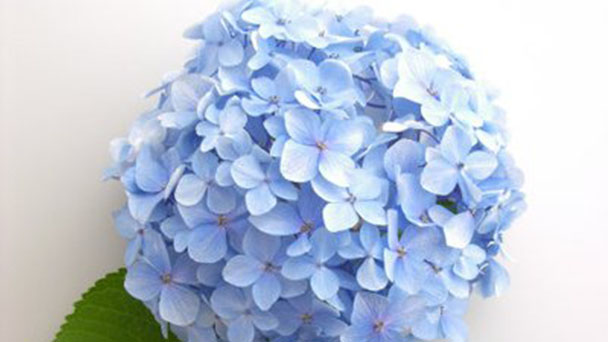Hydrangea Profile
Written by Joy
Mar 30 2021

Hydrangea is also named wooden ball, colorful silk balls pod or glutinous rice dough. A deciduous shrub or small tree belongs to the genus Hydrangea in the family Tigeraceae. Its leaves opposite, ovate to ovate-elliptic, stellate hairy. Summer flowering, flowers terminal cyme, margin with white neutral flowers. The flowers are green at first, then white and fragrant. Because of its shape like hydrangea, so appears the name. Native to Central and southwest China. Nature likes shade wet, afraid of drought and waterlogging. Hydrangea is a common garden flower, its umbels such as snowballs, clustered in the oval green leaves, is really beautiful.

Second, Used for hot lung and throat pain, has the effect of clearing away heat and detoxifying. And external use Fried soup wash, or grind end besmear to lay down, treat scabies, renal cyst wind, have clear heat and stop pruritus effect.

Hydrangea morphological characteristicsHydrangea growth habit and growing environment and distributionHydrangea efficacy and roleHydrangea cultivation
Hydrangea morphological characteristics
Deciduous shrubs or small trees, 3 meters tall. Branches spread, winter buds bare. Leaves opposite, ovate to ovate-elliptic, surface dark green, abaxially stellate pubescent, margin serrate. Summer flowering, flowers terminal integrated large globose cymes, margin with white neutral flowers. Flowering from April to May, 18-20 cm in diameter, all sterile flowers. The flowers are green at first, then white and fragrant. Because of its shape like hydrangea, so the name.Hydrangea growth habit and growing environment and distribution
Hydrangea is originally from China and Japan. Prefers warm, humid and semi-cloudy environment. The suitable temperature for the growth of hydrangea is 18-28℃, and the winter temperature is not less than 5℃. Flower bud differentiation needs 6-8 weeks at 5-7℃, 20℃ can promote flowering, maintain 16℃ after flowering, can prolong flowering period. But the heat fades the flowers quickly. Hydrangea basin soil should be kept moist, but not too much watering, especially in the rainy season to pay attention to drainage, prevent the root rot from waterlogging. Winter indoor pot hydrangea to a little dry had better. Too much moisture makes the leaves perishable. Hydrangea is short sunshine plants, dark treatment more than 10 hours a day, about 45-50 days to form flower buds. Usually cultivation to avoid the sun irradiation, 60%-70% shading is the most ideal.Hydrangea efficacy and role
First, Roots, leaves and flowers can be used for malaria. They have anti-malaria and antipyretic effects. Usually used alone or in combination with herbaceous plants.Second, Used for hot lung and throat pain, has the effect of clearing away heat and detoxifying. And external use Fried soup wash, or grind end besmear to lay down, treat scabies, renal cyst wind, have clear heat and stop pruritus effect.
Hydrangea cultivation
Flower bud differentiation needs 6 ~ 8 weeks under the condition of 5 ~ 7℃, 20℃ temperature can promote flowering, after the appearance of flowers to maintain 16℃, it can prolong the flowering period. But the heat fades the flowers quickly. Hydrangea is a short day plants, dark treatment more than 10 hours a day, about 45 to 50 days to form flower buds. Potted hydrangeas are commonly used in POTS of 15 ~ 20 cm. Water the pot plants well after they sprout in the spring to make sure their leaves don't wilt. July flowering, fertilizer and water to be sufficient, every half a month fertilizer once. Usually cultivation to avoid the sun irradiation, 60% ~ 70% shade is the most ideal. When midsummer illumination is too strong, proper shade can prolong the flowering period. After flowering, the stem is removed to facilitate the production of new branches.
Latest Updated
- Benefits of Bugleweed - 7 Science-backed Health Benefits
- Bugleweed Dangers & Side Effects - Is It Poisonous?
- How to Plant Evergreen Trees - What You Should Know
- When to Plant Evergreens - Grow Guide for Evergreen Trees
- 12 Wonderful Evergreen Shrubs for Your Garden
- 12 Popular Evergreen Plants with Pictures for Beginners
- When And How To Prune A Lilac Bush Like a Pro
- How to Grow & Care for Lilac Vine (Hardenbergia Violacea)
- Japanese Lilac Tree (Syringa Reticulata) Care & Propagation Guide
- Shumard Oak Pros and Cons - What to Know
Popular Articles
- Winter maintenance of Antirrhinum Majus
- How to Grow Terminalia Mantaly Tree
- How to Grow and Care for Crossostephium Chinense
- How to grow Antirrhinum Majus in spring
- Peristeria Elata (Dove Orchid) Profile: Info & Care Guide
- Underwatered Snake Plant (Sansevieria Trifasciata) - Signs And How To Fix
- How to Care for Brazilian Jasmine Plant (Mandevilla Sanderi)
- How to Grow & Care for Graptopetalum Purple Delight in Summer
- Rosa Chinensis (China Rose): Plant Growing & Care Tips
- How to Care for Baby Sun Rose (Aptenia Cordifolia)